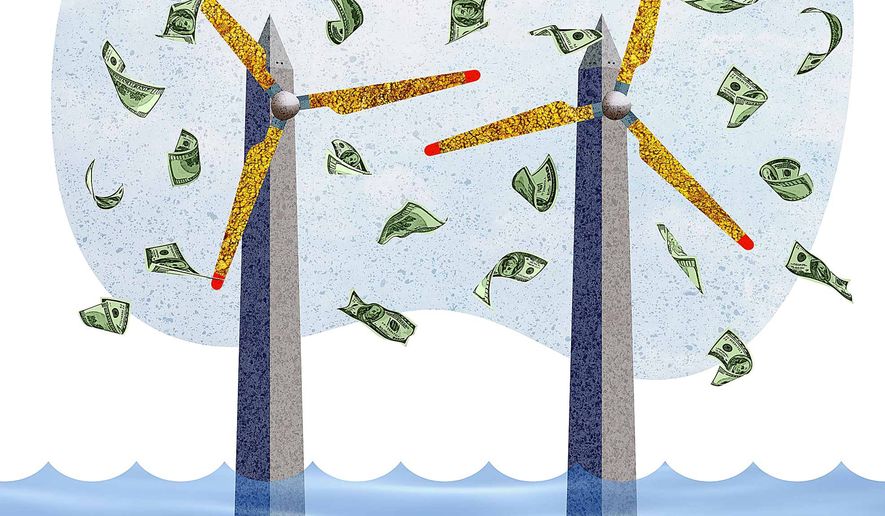OPINION:
If you like power when it’s available, instead of when you need it; having your lights, heat, computer and TV go off and on 30 times a day; and paying 78 cents a kilowatt-hour, instead of 9 cents — you’ll love Dominion (Virginia) Energy’s plan to install two Washington Monument-sized wind turbines off the Norfolk coast.
Virginia lawmakers recently approved an offshore wind project — with no competitive bidding and an estimated cost of $300 million. Virginians will pay 25 times the U.S. market price for the turbines — and then pay 78 cents/kilowatt-hour for their intermittent electricity. That’s 26 times the 3 cents per kWh wholesale price for coal, gas, hydroelectric or nuclear electricity in the Commonwealth.
State utility regulators blasted the decision. The legislature nevertheless enacted it at the behest of Gov. Ralph Northam, to demonstrate his commitment to “fighting climate change.” After the two “demonstration” turbines run awhile, they could be joined by hundreds more.
That forest of turbines would impact surface and submarine ship traffic, and constant vibration noises will impair marine mammals’ sonar navigation systems.
But when green preening and climate virtue-signaling is the objective, not even the Republican Virginia Legislature will be shackled by energy, environmental or economic reality. Here are some relevant facts. Consumers demand and require reliable, affordable electricity 24/7/365. Weather dependent, intermittent wind power requires 100 percent backup by coal or gas power plants that are running all the time on “spinning reserve,” ready to step in every time the wind dies down. That means extra costs, materials and fuels for the backup units.
Wind power often fails when electricity is most urgently required. Industrial wind promoters claim turbines generate electricity about a third of the time: a 33 percent “nameplate capacity factor.” Energy experts put actual output at 20 percent to 30 percent or even lower, depending on locations.
During the July 2006 California heat wave, turbines generated only 5 percent of nameplate capacity. In Texas, wind capacity factors are generally below 9 percent and Lone Star State non-coastal turbines have an historical capacity factor of 12 percent during torrid summer months, and often a third of that.
Wind generation was virtually non-existent in the Pacific Northwest in January 2009. Amid a 2012 heat wave, northern Illinois electricity demand averaged 22,000 megawatts, but turbines generated a miserly 4 MW. Similar realities prevail across the United States and world.
The problem worsens as turbines age. One British study found that onshore wind electricity output declines by 16 percent per decade of operation. It’s worse offshore, because of storms and salt spray.
Offshore wind is also very expensive. The first U.S. offshore wind farm went online off Rhode Island in 2017 — at $150,000 per household powered. The newest U.S. nuclear reactor cost $4.7 billion but powers 4.5 million homes — at $1,040 per household.
Rhode Island offshore wind electricity costs 24.4 cents/kWh today. Under its contractual price escalator of 3.5 percent a year, in 20 years Rhode Island consumers will be paying twice that.
Decommissioning (removing) wind turbines is enormously difficult and hugely expensive. Natural gas plants have 30-40 year lifetimes; nuclear plants can operate for 60 years or more. Wind turbines last 15-20 years, and often far less for offshore leviathans. Off Virginia, salt corrosion is compounded by 50-80 foot storm waves and category 1-3 hurricanes.
Maintenance and removal require huge derrick barges and can be done only during near-perfect weather, with minimal wave height. Actual removal costs depend on the size and type of project, distance from shore, whether monopiles and electrical cables must be fully removed, and whether the seabed must be returned to its original condition.
Virginia’s turbines will be 27 miles from the coast. The cost of removing any industrial-scale “wind farm” could run into the billions, and could double the cost of wind power.
Oil, mining, logging, construction and other projects are typically required to post sizable bonds, before they are permitted to operate. Wind turbine projects are generally exempt. That means billion-dollar decommissioning costs will likely bring corporate insolvency — and state taxpayers and ratepayers will get stuck with the bills.
Demolition has begun for one of Europe’s earliest offshore wind projects, off Denmark. The blades, nacelle and tower must be dismantled and individually removed by big mobile cranes on enormous barges. The concrete foundations must be dismantled on-site by hydraulic demolition shears, then hauled ashore.
By 2023 more than 10,000 of Germany’s 28,000 wind turbines must be decommissioned. Their concrete and rebar bases can be 100 feet in the ground. Rotor blades are fiberglass, carbon fibers and petroleum resins; burning them releases dust and toxic gases, and thus is prohibited. Nor can they be recycled. The same facts apply to U.S. turbines.
Imagine putting 115-foot turbine blades in landfills — or 245-foot blades from the new monster turbines. One study estimates that it will cost $565,000 per megawatt to decommission Europe’s offshore turbines — or about $3.4 million for each new generation 6-MW turbine.
From an economic, environmental or energy perspective, this is simply unsustainable. And it’s all being justified by climate change hyperbole and hysteria.
Gov. Northam and legislators who supported this fiasco should be prosecuted for energy and climate fraud — or at least forced to run their homes and offices in perpetuity on intermittent, ultra-expensive electricity from wind turbines.
• Roger Bezdek is president of Management Information Services Inc. Paul Driessen is senior policy analyst for the Committee For A Constructive Tomorrow.




Please read our comment policy before commenting.